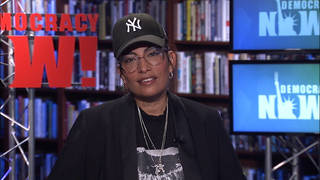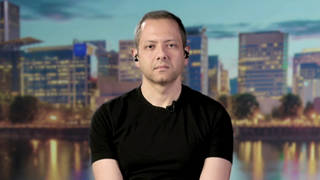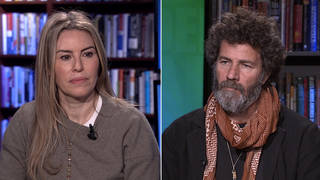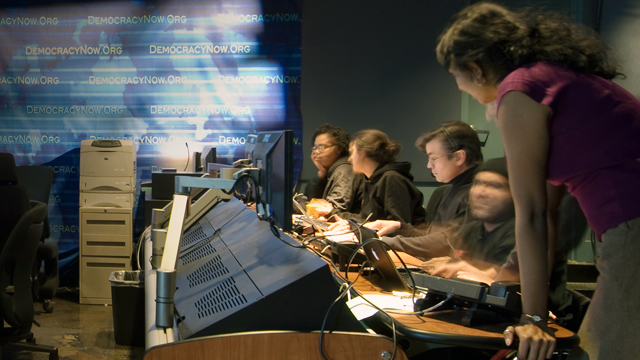
Guests
- Julia Butterfly Hillenvironmental activist and member of North Coast Earth First!
For more than four months, environmentalist activist Julia Butterfly has been perched 180 feet high in a 1,000-year-old redwood tree. In Northern California, during the record tree-sitting protest, Ms. Butterfly has withstood the heavy rains and blasting winds of El Niño’s winter storms, as well as harassment from the logging company Maxxam Pacific Lumber, which has used searchlights and foghorns to disrupt her sleep.
Transcript
AMY GOODMAN: You’re listening to Pacifica Radio’s Democracy Now! I’m Amy Goodman. Coming up on Democracy Now!, we’re going to talk about the organic food standards that have been proposed by the U.S. Department of Agriculture. The deadline is April 30th. We’ll be speaking with an organic farmer in California. About a month ago, we did a show, a debate on the issue, and, to say the least, we got a tremendous number of calls. We’ll be playing some of those comments from around the country. Before that, we’ll be talking to U.S. PIRG, the U.S. Public Interest Research Group, about a report they’ve just put out called “Feeding at the Trough: Big Campaign Contributions Mean Bigger Handouts to Polluters.” We’ll talk about, for example, the Green Scissors campaign, and we’ll talk about how the House voted to support polluter pork for 13 out of 14 votes, and how the Senate consistently votes to support polluter pork programs.
But first, we’re going to revisit a story that we did about a month ago. Yes, today is Earth Day, and we’re going to go out to California to the last stand of ancient redwoods, to a woman named Julia Butterfly, who has been in one of those trees for the past four months. Julia Butterfly has been 180 feet high in a redwood, and she’s protesting the possible cutting down of those trees. She joins us now on the telephone.
Welcome to Democracy Now!, Julia.
JULIA BUTTERFLY HILL: Hello. Thank you very much for having me.
AMY GOODMAN: Well, it’s great to be with us. Can you tell us a little about — we talked to you on the hundredth day of your protest in your 180-foot-high perch. Tell us what you’re doing now.
JULIA BUTTERFLY HILL: Well, I’m doing much of the same, continuing trying to spread the word across the world about what’s happening here, the destruction, as well as trying to stop the logging on this hillside. The trees on this hillside, each and every one of them, are extremely important to hold up this steep and unstable slope that has already slid once and is trying to slide more as they continue cutting. So I’m still carrying on just trying more and more and more to raise public awareness in an effort to stop them.
AMY GOODMAN: Well, you withstood the heavy rains and blasting winds of El Niño’s winter storms, as well as harassment from the logging company Maxxam Pacific Lumber, which has used searchlights and foghorns to disrupt your sleep. Can you explain what the battle is all about again, for listeners who are new to this issue, what Maxxam Pacific Lumber and the state of California and the federal government has to do with this ancient stand of redwoods you’re perched in?
JULIA BUTTERFLY HILL: Well, actually, where I am perched is directly above the town of Stafford, California, where, on December 31st, 1996, going through to the first of '97, a mudslide occurred that completely destroyed seven families' homes in that town below me. And yet, in — that mudslide was a direct result of the logging practices of Pacific Lumber under Charles Hurwitz’s Maxxam Corporation. Then Pacific Lumber asked for an approval of another timber harvest plan on the same hillside, and the California Department of Forestry approved it. Yet we could not understand how they could do this with people’s lives at risk.
But what I’m also working toward is saving all the Headwaters Forest, which is the ancient groves. And right now it’s in Legislature. They’ve been working on the deal, the Headwaters deal, for years, and it’s now coming — it’s now coming to light. And basically, the deal is not a deal. We have less than 3% of our original old-growth forest left, and there is no more compromising, and there is no more dealing on such a small amount of ancient forest left. And that’s currently the battle that we are working with to stop the deal and save all 60,000 acres.
AMY GOODMAN: Julia, the $380 million funding deal to purchase part of the Headwaters Forest is in serious trouble in the California Legislature, which has the power to approve or kill federal funding, and a, quote, “Habitat Conservation Plan,” the HCP, which is the linchpin for the funding, which was negotiated for all of Pacific Lumber’s 205,000-acre property. In recent weeks, a scientific consensus has emerged to oppose the Habitat Conservation Plan, which would seriously imperil the coho salmon and the endangered marbled murrelet. Can you explain what is happening in the state Legislature and why California state Senator Byron Sher of Palo Alto and Democratic state Assemblyperson Carole Migden of San Francisco, who head the Headwaters Legislative Task Force, have said they’re going to work to kill the $380 million in funding for the deal?
JULIA BUTTERFLY HILL: Yes, well, basically, what’s happened is public outcry has said, “No, do not finance the deal.” The Habitat Conservation Plan is, in effect, a license to kill. It does not provide big-enough buffer zones around the water courses for coho salmon. It allows for the destruction of the old-growth trees, which is the only nesting place of the endangered marble murrelet. And enough people began writing them and saying, “Look, this is bad science. There is no — there is not good science behind this.” And one of the biggest reasons being that, in 1996, Pacific Lumber broke environmental laws over 200 times, and then they came back in '97, after being placed on probation, and broke environmental laws over a hundred more times. And yet we're supposed to trust them to provide a Habitat Conservation Plan that’s going to provide for these endangered species. And so, they recognize that the science is not there, and so they’ve placed a halt on it and said these things have to be fixed before they’ll even consider placing the deal through.
*AMY GOODMAN: How has Maxxam Pacific Lumber dealt with you, an Earth Firster, up 180 feet high in this thousand-year-old redwood tree, more recently, after the beginning with the storms and the searchlights and the foghorns to harass you out of the tree?
JULIA BUTTERFLY HILL: Well, the latest reports from John Campbell and Mary Bullwinkle, John Campbell being the CEO of Pacific Lumber and Mary Bullwinkle being their spokesperson, that they’re going to leave me here until I get tired, in their own words. They’ve pretty much — they’ve tried every other avenue, apparently, that they can possibly think of to get me down, and it’s not working. So they’ve decided to leave me here, they said. And that’s the latest report as of yet.
AMY GOODMAN: What are your plans?
JULIA BUTTERFLY HILL: My plans are to do everything in my power to save this hillside from being cut, and to bring about public awareness on the Headwaters Forest and on the issues, the issues being that they cannot take one more ancient tree. There is no compromise. There is no deal. We’re left with — we’re left with less than 3%. That is an endangered amount. Trees are species, and they are endangered at this point, and they will go extinct if they take one more.
We’re also — I want to continue making people aware that they’re cutting too close to water courses, and it’s destroying the coho salmon. And we’re saying, “No more.” We’re also saying, “No more cutting on steep, unstable slopes like this one.” People’s lives are at risk here. Seven families lost their homes. And as they continue to cut, more families’ lives are at risk. We’re also saying, “No more cutting in critical habitat for these threatened endangered species.”
So my plan is to stay up here and continue talking about these things that are happening, and making people stand up and say, “No, we cannot do this. We cannot allow this any longer,” as well as trying to come up with a plan and a solution to save this hillside, and therefore, the town of Stafford below.
AMY GOODMAN: There are a number of groups that have formed a coalition to save the last stand of redwoods in the Headwaters Forest. And I wanted to ask how the coalition is working out. You’re with Earth First!, which is a very uncompromising group. And I say that really as a compliment, but, I mean, you’re known as a group that, you know, stands up for one issue, and you don’t — you don’t back down. You’re with other organizations like the Sierra Club and the Environmental Protection Information Center. How has this coalition held up? And what’s your assessment of where the groups stand?
JULIA BUTTERFLY HILL: Well, that’s one of the things that I think is incredible about today being Earth Day, that on today, all these different groups and all the people from all walks of life are joining together to celebrate the Earth. And what’s happening that I’m seeing with all these different groups is that awareness is being raised, and it doesn’t matter from what walk of life we come from, that we are all, as the body of life, headed towards the same future. And we have to recognize our differences more as diversity, and just as diversity in nature is beautiful and important, there is a diversity in people. And people that — all these different groups are beginning to realize that, and we’re beginning to find what we can do best and using it together to work towards that beautiful future for everyone.
AMY GOODMAN: In the last few weeks, the lead federal negotiators of the Headwater agreement, the deputy secretary of the interior — is his name John Garamendi?
JULIA BUTTERFLY HILL: Yes.
AMY GOODMAN: And Tom Tuchmann from the Department of Agriculture, have announced they’re resigning their posts. So, who’s going to broker support for the deal in the California Legislature?
JULIA BUTTERFLY HILL: Unfortunately, I don’t know that answer. I wish I did. I rely heavily on my incredible, incredible ground support crew to be in contact with my media support crew to give me information like that. And I guess, as of yet, I haven’t received that information. But there is websites, and there are addresses that people can contact if they’d like to find out more of the logistics, because I’m sorry that I don’t have that answer.
AMY GOODMAN: Julia Butterfly. What do you do every day up in the redwood tree? What time do you wake up in the morning, for example?
JULIA BUTTERFLY HILL: Well, it’s different every day. You know, the first thing is that when you get rid of electricity, that your body can go back on natural biorhythms, and you go to sleep when you’re tired, and you wake up when you’re ready to. But with this becoming a media — an area that the media has gotten interested in my ability to — my being very, very blessed with being able to tell the world about what’s happening, I spend a lot, a lot of time speaking with various groups and radio stations, television stations, newspapers, etc.
And another big part of my day is prayer. I believe very strongly in prayer. I want people to understand that this isn’t something about the environmentalists versus the workers or the environmentalists versus the people, that this is — that the destruction that’s happening to the environment is a direct reflection of the destruction of our lives, and the town of Stafford being a very unfortunate but very real example of that. So I spend a lot of time praying, asking that people — asking for guidance from the spirit of the universe, that people will understand that I’m not just a tree hugger, but that I’m a people hugger and that I care about them, and what we’re doing here is providing for a sustainable, beautiful future for the environment and for the people’s lives, as well.
AMY GOODMAN: How do you get your food?
JULIA BUTTERFLY HILL: My incredible ground support crew. They have been so phenomenal. They have been so important every step of the way. They bring me food; water, when I’m not able to collect it off the tarp, since it has not been raining recently; all the information. Like I said, they’ve been very vital in carrying information from the world of, quote, unquote, “down there” to the world of up here. And they’re just — they’re just really vital and important to this sit-in.
AMY GOODMAN: If people want to get in touch with you, with Earth First!, with the environmental groups that are fighting to preserve the stand of redwoods, where can they call, and where can they go on the internet?
JULIA BUTTERFLY HILL: OK, well, the internet website, let’s see. There’s a lot of different ones, actually.
AMY GOODMAN: I would guess that the internet is far away from you up there.
JULIA BUTTERFLY HILL: Yes, exactly. OK, there is — if they want just a website, it is www.NorthCoast.com/~ — that is the little upside-down —
AMY GOODMAN: Squiggly line.
JULIA BUTTERFLY HILL: Squiggly line, yes — sohum/luna. If they want email, there is LunaNews@humboldt1.com.
AMY GOODMAN: And Humboldt is H-U-M?
JULIA BUTTERFLY HILL: B-O-L-D-T.
AMY GOODMAN: Dotcom. And a phone number people can call?
JULIA BUTTERFLY HILL: 44 — I’m sorry. Area code 707-445-5105.
AMY GOODMAN: That’s 707-445-5105.
JULIA BUTTERFLY HILL: Yes, there’s also the same area code 707-445-3344.
AMY GOODMAN: That’s 707-445-3344. Well, I want to thank you very much for joining us, Julia Butterfly, and we hope to check in again with you soon. Or maybe it won’t be necessary, because maybe you’ll get what you want.
JULIA BUTTERFLY HILL: Exactly.
AMY GOODMAN: Well, thank you very much, Julia Butterfly, who’s just been disconnected from her cellular phone to us. She is up in a 1,000-year-old redwood tree, 180 feet high, and she has been there for four months. You are listening to Pacifica Radio’s Democracy Now! When we come back on this Earth Day, we’re going to take a look at big campaign contributions from major polluters. Stay with us.












Media Options